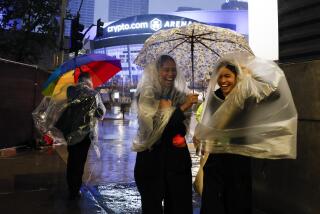This year will likely be critically dry for California, state officials say
- Share via
The winter storms that dumped heavy snow and rain across California early in 2021 are likely not enough to negate what will be a critically dry year, state water officials believe.
California’s Department of Water Resources on Tuesday recorded a snow depth of 56 inches and water content of 21 inches at Phillips Station in the Sierra Nevada. The water content of the overall snowpack was 61% of the average for March 2 and 54% of the average for April 1, when it is historically at its maximum.
Surveys of the Sierra snowpack, which normally supplies about 30% of California’s water, are a key element of the department’s water-supply forecast.
December, January and February are typically the wettest part of the “water year,” which starts Oct. 1. In January, when L.A. should have received 3.12 inches of rain, only 2.44 inches fell.
Without any serious storms on the horizon, California will end this year dry, Sean de Guzman, the department’s chief of Snow Surveys and Water Supply Forecasting, said at a Tuesday news conference.
Though Californians have made progress in embracing wise water habits, “our state’s water future remains uncertain due to the variability in precipitation and changing climate,” he said.
“It’s more critical than ever that Californians adopt sustainability, embrace new approaches and emerging technologies and work together to save water for a secure future,” he added.
California’s reservoirs are beginning to see the impact of a second consecutive year with below-average precipitation across the state, de Guzman said. Among the largest, Lake Oroville is at 38% capacity, and Don Pedro Reservoir is at 68% capacity, he said. California’s largest surface-water reservoir, Shasta Lake, is at 50% of capacity.
Phillips Station recorded more precipitation than other locations around the state. It’s located in the central Sierra, where storm systems in January and February dumped heavy amounts of rain and snow. Stations further south have less precipitation, de Guzman said.
This year is so far similar to 2014, which came in the midst of California’s most recent severe drought, which ran from 2012 to 2016. The two most challenging years were 2014 and 2015, California’s warmest on record dating back a century. Last year was California’s third-warmest on record.
A storm is expected to dump up to half an inch of rain across much of Southern California Wednesday, possibly including the southern portion of L.A. County.
More rain is expected this weekend and late next week, but “it’s nothing too significant of a storm to write home about quite yet,” de Guzman said.
Associated Press contributed reporting.
More to Read
Sign up for Essential California
The most important California stories and recommendations in your inbox every morning.
You may occasionally receive promotional content from the Los Angeles Times.











